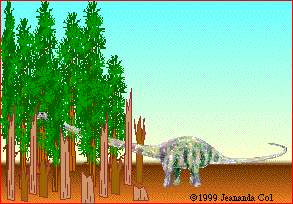
 |
| ZoomDinosaurs.com ALL ABOUT DINOSAURS! |
| What is a Dinosaur? | Dino Info Pages | Dinosaur Coloring Print-outs | Name That Dino | Biggest, Smallest, Oldest,... | Evolution of Dinosaurs | Dinos and Birds | Dino Myths |
 Mamenchisaurus held its neck more-or-less horizontally (parallel to the ground). The long neck may have been used to poke into forests to get foliage that was otherwise unavailable to the huge, lumbering varieties of sauropods who could not venture into forests because of their size. Alternatively, the long neck may have enabled this sauropod to eat soft pteridophytes (horsetails, club mosses, and ferns). These soft-leaved plants live in wet areas, where sauropods couldn't venture, but perhaps the sauropod could stand on firm ground and browse in wetlands.
Mamenchisaurus held its neck more-or-less horizontally (parallel to the ground). The long neck may have been used to poke into forests to get foliage that was otherwise unavailable to the huge, lumbering varieties of sauropods who could not venture into forests because of their size. Alternatively, the long neck may have enabled this sauropod to eat soft pteridophytes (horsetails, club mosses, and ferns). These soft-leaved plants live in wet areas, where sauropods couldn't venture, but perhaps the sauropod could stand on firm ground and browse in wetlands.
Its main food was probably conifers, which were the dominant plant when the large sauropods lived. Secondary food sources may have included Gingkos, seed ferns, cycads, bennettitaleans, ferns, club mosses, and horsetails.
BEHAVIOR
Mamenchisaurus may have travelled in herds and possibly migrated when they depleted their local food supply. Mamenchisaurus may have hatched from eggs, like other sauropods. Sauropod eggs have been found in a linear pattern and not in nests; presumably the eggs were laid as the animal was walking. It is thought that sauropods did not take care of their eggs. Sauropods life spans may have been in the order of 100 years.
INTELLIGENCE
It used to be thought that the sauropods (like Mamenchisaurus, Brachiosaurus and Apatosaurus) and Stegosaurus had a second brain. Paleontologists now think that what they thought was a second brain was just an enlargement in the spinal cord in the hip area. This enlargement was larger than the animal's tiny brain.
Mamenchisaurus was a sauropod, whose intelligence (as measured by its relative brain to body weight, or EQ) was the among the lowest of the dinosaurs.
WHEN MAMENCHISAURUS LIVED
Mamenchisaurus lived during the late Jurassic Period, from about 156 million to 145 million years ago. The late Jurassic was a period when the Earth was very warm, the sea level were high, and there was no polar ice. This was also the time when the enormous sauropods (long-necked dinosaurs) roamed the Earth; these giants included Camarasaurus, Apatosaurus, Diplodocus, and Brachiosaurus. Also present were Stegosaurus, Tuojiangosaurus, Allosaurus, Supersaurus, Coelurosaur, and many other dinosaurs.
FOSSILS
Mamenchisaurus was named by Chung Chien Young, a Chinese paleontologist, in 1954. Fossils have been found in China.
CLASSIFICATION
Mamenchisaurus belonged to the:
 (and Other Prehistoric Creatures) |
Enchanted Learning®
Over 35,000 Web Pages
Sample Pages for Prospective Subscribers, or click below
|
Overview of Site What's New Enchanted Learning Home Monthly Activity Calendar Books to Print Site Index K-3 Crafts K-3 Themes Little Explorers Picture dictionary PreK/K Activities Rebus Rhymes Stories Writing Cloze Activities Essay Topics Newspaper Writing Activities Parts of Speech Fiction The Test of Time
|
Biology Animal Printouts Biology Label Printouts Biomes Birds Butterflies Dinosaurs Food Chain Human Anatomy Mammals Plants Rainforests Sharks Whales Physical Sciences: K-12 Astronomy The Earth Geology Hurricanes Landforms Oceans Tsunami Volcano |
Languages Dutch French German Italian Japanese (Romaji) Portuguese Spanish Swedish Geography/History Explorers Flags Geography Inventors US History Other Topics Art and Artists Calendars College Finder Crafts Graphic Organizers Label Me! Printouts Math Music Word Wheels |
Click to read our Privacy Policy
| Search the Enchanted Learning website for: |